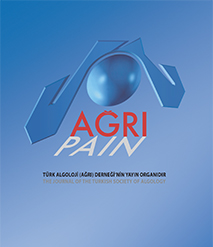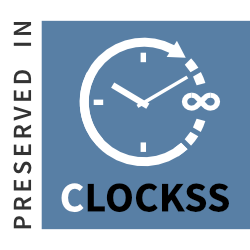Quick Search
Volume: 19 Issue: 3 - 2007
| REVIEW | |
| 1. | Neuropathic pain Nerses Bebek, Mustafa Ertaş PMID: 18095193 Pages 5 - 10 Neuropathic pain is caused by functional abnormalities of structural lesions or dysfunction in the peripheral or central nervous system, and occurs without peripheral nociceptor stimulation. Neuropathic pain has a great impact on the quality of life. Majority of the patients are unable to maintain an independent lifestyle due to their moderate to severe chronic pain and often depression contributes to the illness. Many common diseases, such as stroke, multiple sclerosis and syringomyelia may produce neuropathic pain. Neuropathic pain is a complex disease, involving several molecular pathways. Neuropathic pain treatment is stil extremely difficult despite our knowledge about this difficult to diagnose and treat pain condition has improved a lot with the aid of recent experimental and clinical studies. This review summarizes the underlying mechanisms, diagnosis and treatment approaches based on different mechanisms of effect. |
| 2. | Gamma knife radiosurgery for treatment of pain Selçuk Peker, Meriç Şengöz PMID: 18095194 Pages 11 - 15 Radiosurgery is to irradiate the small volume targets inside of the cranium with high dose radiation in a single session. Gamma knife radiosurgery has been in use for treatment of pain many years. The first cases which have been treated with radiosurgery technique were trigeminal neuralgia patients. After the first installment of gamma knife in 1968, it has been used for thalamotomy in cancer pain. Nowadays the main indication for gamma knife radiosurgery for pain is trigeminal neuralgia. |
| EXPERIMENTAL AND CLINICAL STUDIES | |
| 3. | Pediatricians’ and pediatric nurses' knowledge about pain in newborn infants and their practices in some provinces in Turkey Emine Efe, Emine Altun, Hacer Çetin, Ayşegül İşler PMID: 18095195 Pages 16 - 25 This research was conducted as a descriptive study for the purpose of determining the status of pediatricians and nurses who work on pediatric wards about their recognizing, evaluating, and using appropriate nonpharmacologic interventions to treat pain in newborn infants. The study was conducted between March and May 2005. A total of 198 nurses and physicians were included in the sample, 31 of whom were from Sivas 1st İzzettin Keykavus State Hospital, 76 from Akdeniz University Medical Faculty Hospital, 45 from Mersin University Medical Faculty Research, Mersin State and Taurus State Hospitals and 46 from Ege University Medical Faculty Hospital. The data were collected using a 16-question survey form. Five of the survey questions were regarding the nurses' and physicians' sociodemographic characteristics and 11 contained questions directed at obtaining physicians and nurses' information about pain in newborns. The results of the research showed that the physicians and nurses were knowledgeable about newborn pain. It was determined that the pediatric nurses used nonpharmacologic methods during invasive procedures in the newborns but the physicians did not. In conclusion it is recommended that this issue receive more discussion in continuing education programs at hospitals for the purpose of encouraging nurses and physicians to use nonpharmacologic methods during invasive procedures that are done in newborns to facilitate a multidisciplinary team approach for pain management in newborn infants. |
| 4. | The Postoperative Analgesic Effects of Magnesium Infusion on Brachial Plexus Block Özlem Anbarcı, Alparslan Apan, Şaziye Şahin PMID: 18095196 Pages 26 - 31 Magnesium sulphate infusion decreases analgesic requirements after general anaesthesia. Aim of this study was to assess the effects of postoperative magnesium infusion for 24 hours on duration of the block, sedation and postoperative analgesic consumption after brachial plexus block. After obtaining approval from local ethic committee, 70 ASA class I and II patients were included to the randomised double blind study. Brachial plexus block was performed using axillary approach with lignocaine 1.25 % adrenaline 1/200 000 40 ml. Groups received 5 mg.kg –1 bolus and 500 mg.h–1 magnesium sulphate infusion or saline controls at the same volume during 24 hour. Analgesia and sedation were assessed while determining time to first pain and rescue analgesic, time to regain motor capability, visual analogue scale and sedation scores for every 4 hour during postoperative 24 h. period. While time to first pain and rescue analgesic was increased, total analgesic consumption was reduced significantly on magnesium infusion group (Meperidine: C: 36.3 ± 42.6 mg, Mg: 11.7 ± 12.2 mg, p: 0.001). Visual analogue scales were also observed to be lower in all periods. Time to motor block resolution, and sedation scores were similar. Magnesium sulphate infusion is thought as a safe and suitable adjunct for reducing analgesic consumption and possible complications without interfering daily activity in patients undergoing brachial plexus block. |
| 5. | Effect of preoperative 900 and 1200 mg single oral dose of gabapentin on postoperative pain relief and tramadol consumption in open cholecystectomy surgery Suna Akın Takmaz, Çetin Kaymak, Başak Şare Pehlivan, Bayazit Dikmen PMID: 18095197 Pages 32 - 38 In this study, the effects of preoperative 900 and 1200mg single dose of gabapentin on postoperative pain relief and tramadol consumption in elective open cholecystectomies were investigated. Fourtyfive ASAI-II patients were randomly divided into three groups. GroupI was control group and patients in groupII and III received 900mg or 1200mg gabapentin 1 hour before the operations respectively. All patients received intravenous tramadol at the end of surgery via a PCA device. Pain scores were evaluated at the recovery room(0),1,2,3,4,6,8,12 and 24h postoperatively at rest and movement, using a 10cm VAS. In the recovery room, VAS scores at rest were three times less (1,4±0.6 versus 4,9±1.0 and 4.4±1.1), and VAS scores at movement were two times less (3.4±1.0 versus 6.8±1.8 ve 6.1±1.6) in groupIII when compared to groupI and II respectively. Mean loading doses were significantly lower in groupIII (28.3±8.7) than groupI (66.6±20.4) and II (61.6±20.8). VAS scores at rest during the postoperative first 6h and at movement during the postoperative first 8h were significantly lower in groupIII than groupI and II. Total tramadol consumption was lower in groupIII (240.4±31.0), than groupI (456.0±35.5) and groupII (438.7±35.0). Additional meperidine was necessary for two patients both in groupsI and II, although none of the patients needed in groupIII. Higher patient satisfaction scores were obtained in group III. Adverse effect incidences were higher in groupI and II than in groupIII. As a result, we believe that to improve analgesic quality after open cholecystectomy, preoperative single dose of gabapentin should at least be 1200 mg. |
| 6. | Usage of remifentanil and fentanyl in intravenous patient-controlled sedo-analgesia under topical anaesthesia during cataract surgery Ayten Akgül, Osman Nuri Aydın, Volkan Dayanır, Selda Sen, Bakiye Ugur, Erkin Kır PMID: 18095198 Pages 39 - 46 Aim was to investigate the effects of patient-controlled sedo/analgesia with fentanyl or remifentanil during cataract surgery with phacoemulsification method under topical anaesthesia. The Ethical committee has approved the prospective, randomized, double-blind study. ASA I-III, 120 patients underwent cataract surgery were randomly allocated to 3 groups. Fentanyl was administered in 0.7 μg/kg loading, 10 μg bolus dose with 5 minutes lockout time, remifentanil was administered 0,3 μg/kg loading, 20 μg bolus dose with 3 minutes lockout time by PCA equipment. In the control group, saline solution was given without any analgesic drug. Cardiorespiratory system findings, verbal pain scale and sedation scores were recorded preoperatively and intraoperatively at the 5th, 10th, 15th, 20th and 30th minutes. Discomfort during surgery, pressing the PCA button, and complications were observed. The Verbal pain scale score was significantly lower in the drug groups than the control group at the 15th minute. The sedation score was significantly higher in the remifentanil group at the 5th minute (p=0,019) and in the fentanyl group at the 10th minute (p=0,007) than the control group. The number of patients pressing the PCA button was much higher in the control group than the drug groups (p<0.05). Patient comfort and surgeon satisfaction were higher in the drug groups (p<0,05). Patient-CA is a convenient and safe method, especially at the beginning of the operation when anxiety is intense, and during healon/lens implantation. Intravenous-PC sedo/analgesia addition to topical anaesthesia provides an advantage in sedo/analgesia, patient comfort, and surgeon satisfaction. |
| CLINICAL CONCEPTS AND COMMENTARY | |
| 7. | Neurofeedback in fibromyalgia syndrome Sadi Kayıran, Erbil Dursun, Numan Ermutlu, Nigar Dursun, Sacit Karamursel PMID: 18095199 Pages 47 - 53 EEG Biofeedback (Neurofeedback-NFB) is a learning strategy that enables people to alter their brainwaves. In the present case study, we applied a NFB protocol on three patients with Fibromyalgia Syndrome (FMS). The existing symptoms and clinical conditions of the patients attributed to FMS, Visual Analog Scale for pain and fatigue, Hamilton Depression and Anxiety Inventory Scales, Beck Depression and Anxiety Inventory Scales, and SF-36 were recorded before and after NFB training. Most of the symptoms were decreased after ten sessions. There was also improvement in all of the scales after the treatment. The results of the present study may suggest NFB training as a novel treatment method in FMS. |
| 8. | Neuropathic arthropathy caused by syringomyelia in different joints and lesion of brachial plexus at right upper extremity: A case report Ayşe Ekim, Onur Armagan PMID: 18095200 Pages 54 - 59 Syringomyelia is characterized by slow progression; the joints involved most frequently are the shoulders and elbows. Neuropathic arthropathy of the hand is quite rare. Herewith, we present a case of neuropathic arthropathy (NA) of the joints in the upper limb secondary to Syringomyelia. Atypical features of the case included NA of the shoulder, elbow and metacarpophalengeal joint in the same upper limb. These atypical features superimposed shoulder subluxation and brachial plexopathy which diagnosed by electrophysiologic studies. To the best of our knowledge, our study is the first of its kind that reports a patient who had all the abovementioned symptoms in the same upper limb. |





